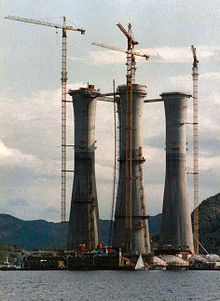Gravity-based structure

A gravity-based structure (GBS) is a support structure held in place by gravity. The most notable application for a GBS is an offshore oil platform. These structures are often constructed in fjords since their protected area and sufficient depth are essential for construction. A GBS intended for use as an offshore oil platform is constructed of steel reinforced concrete, with tanks or cells, some of which are used to control the buoyancy of the GBS. When completed, a GBS is towed to its intended location and sunk. Prior to deployment, a study of the seabed has to be done in order to ensure it can withstand the vertical load exerted on it by that structure.[1]
Gravity-based structures were also used for early deployments of offshore wind power turbines. As of 2010, 14 of the world's offshore wind farms had some of their turbines supported by gravity-based structures. GBS are uneconomic for water depths less than 20 m. The deepest registered offshore wind farm with gravity-based structures is Thornton Bank 1, Belgium, with a depth up to 27.5 m.[2] Newer generations of wind turbines are much larger, and deployed in deeper waters, the GBS is no longer considered competitive in comparison with other support structures, e.g. floating moored.
See also
- Offshore concrete structure
- List of tallest oil platforms
- Troll A platform
- Gullfaks C
- Hibernia (oil field)
References
- ^ Dean, E.T.R. (2010). Offshore Geotechnical Engineering - Principles and Practice. Thomas Telford, Reston, VA, U.S.A., 520 p.
- ^ "LORC Knowledge. "Datasheet for site: Thornton Bank 1 offshore wind farm", 2011".
